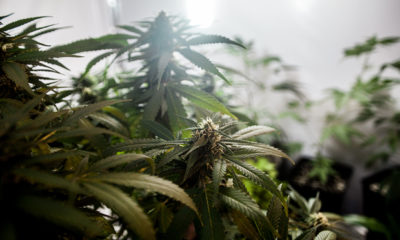
Economics
Croptober: Why Observers Say 2022 Feels Different.
With major cannabis companies posting massive losses and investor capital drying up, the fall of fail may be upon us.
Like California fire season, “Croptober”—the term for the annual flood of sungrown cannabis entering the market during the fall harvest and the subsequent price shock, as supply on hand far outstrips demand—is now a yearlong phenomenon.
But this year aims to be worse for everyone, as October is due to bring bad tidings for c-suite types and investors in Big Weed. With the third quarter closing Sept. 30 and the next earnings reports for publicly traded companies due beginning Oct. 15, “Croptober” is on track to be “Crashtober,” the autumn of major cannabis companies’ serious problems.
Anticipating this, the #MSOgang appears to be getting ahead of the trouble. Rather than blame consumers for not buying enough cannabis or themselves for growing too much, a parade of executives and investors recently told POLITICO that the real problem is Congress, and that the real reason they have been gushing cash for years now is lawmakers’ failure to pass any number of significant cannabis reform bills.
While federal tax law and federal prohibition no doubt play a significant role, these are also not new problems for cannabis businesses. But as several observers, entrepreneurs and other cannabis business types contacted for this article said, 2022 feels different.
Investors are tired of seeing companies burn their cash. And with more than a half-billion in losses through half of 2022, companies are running out of cash to burn.
The American version of Canada’s great bubble bursting, predicted by Cannabis Now earlier this summer, might be coming sooner than we anticipated.
Just the Feds, Ma’am
Continuing a trend seen all year long—and in defiance of otherwise across-the-board inflation— cannabis prices continue to decline almost everywhere the plant is legal for Americans to buy and consume, according to recent data compiled by Cowen, one of the leading analyst houses tracking the industry. About the only place prices are high(ish) and stable are in states with new adult-use markets with limited competition, such as New Jersey.
Though most every major cannabis company in the United States has a presence in New Jersey as well as New York, where the most recent news is that licensed and regulated retail sales won’t start until 2023, almost a full two years after legalization—and both states have enormous potential measured in the billions of dollars, according to market forecasts—mere promise doesn’t appear to be enough to satisfy the concerns of investors big and small.
Despite revenue from legal cannabis projected to hit $32 billion this year and $72 billion by the end of the decade, big marijuana companies are pleading poverty. So far, the country’s two dozen biggest publicly traded firms lost a combined $550 million on revenues of $4.5 billion, as per POLITICO.
Some observers have said that cannabis companies themselves are at least partly to blame—that, maybe, they invested too much in enormous grow facilities that don’t produce enough good cannabis, or at least produced enough mediocre cannabis to depress prices and encourage consumers to shop on the traditional market. But at least publicly, most investor types are blaming lawmakers.
“The idiots in Washington are causing the problem,” as Matt Hawkins, a private equity veteran and founder of Entourage Effect Capital, which sunk big money into MSOs including Green Thumb Industries, told POLITICO. “They need to understand that in order for this industry to grow and thrive that has to be passed.”
Even advocates of small weed agreed with the general analysis. Everybody is hurt hard by tax code Section 280, which forbids cannabis businesses from making the normal tax deductions—deductions that, for other firms, mean the difference between profit and a loss, or a tiny margin or a fatter one.
“Obviously every business’ situation is different, but I would concur that federal policy is about the most significant impediment to positive cash flow, particularly the impact of 280E,” said Aaron Smith, executive director of the National Cannabis Industry Association, which advocates for small businesses. “The situation is worse for smaller businesses which cannot withstand extended periods of losses.”
That said, Smith’s sympathy is limited for large firms who based revenue projections on assumptions that federal policy would change—and then “didn’t and don’t invest in the effort to change federal policies either,” he said.
Dealing With the Flow
Observers note that cannabis executives appear to be admitting there’s trouble in various ways, sometimes subtly, sometimes very obviously. Companies have already laid off hundreds of workers across the country, as MJBizDaily reported last month.
At the recent Benzinga Cannabis Capital Conference in Chicago, Curaleaf founder and chairman Boris Jordan turned heads with the prediction that 50% of cannabis sales “five to ten years out” will be infused beverages, with the other half (presumably) split between flower, edibles and vape cartridges currently dominating the market.
The prediction earned Jordan some headlines in the business press and some mockery on Twitter, but he may also have tipped his hand.
In an interview with Benzinga, Jordan also predicted that significant federal legislation would be coming by the end of the year.
He made a similar prediction—that the SAFE Banking Act, federal legislation that would allow better access to banks and investors for state-legal cannabis businesses, would pass during the lame duck session between the midterm elections and the next session of Congress—back in May.
He may be legitimately hopeful, and he may be right, but by hedging his bets that federal help is coming—or even something better five years down the road—he may also be speaking to anxious and impatient investors, wondering when (if ever) their returns are coming. Something must change, but if it’s not federal policy, cannabis companies will need to make a major correction starting as soon as this fall—the fall of fail.
























